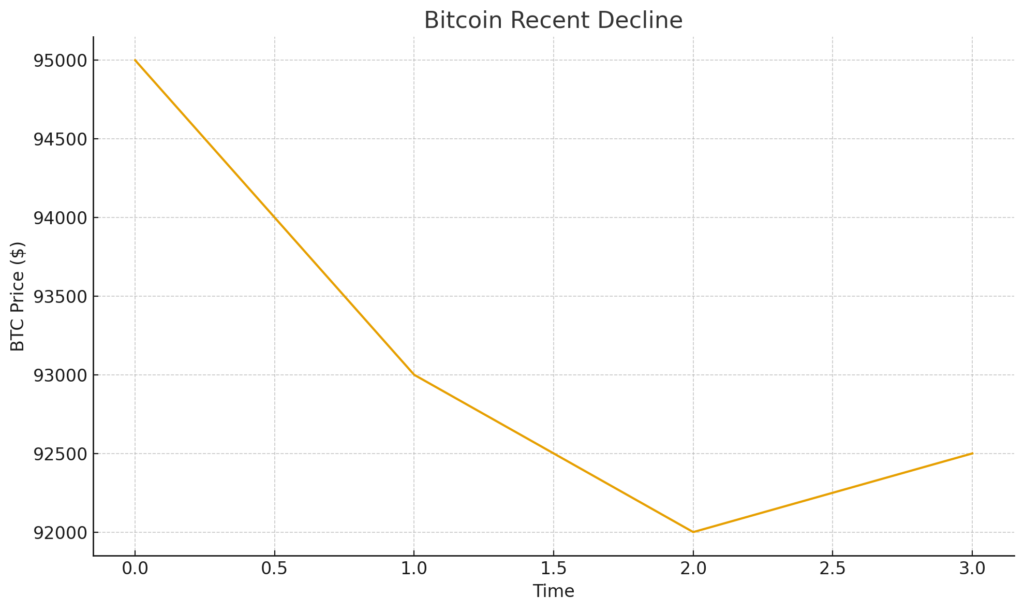
Main Points :
- Bitcoin fell below $93,000, erasing all gains for 2025 and marking a 27% decline from its all-time high in October.
- Stronger-than-expected U.S. economic indicators reduced expectations of a Federal Reserve rate cut.
- Analysts identify heavy capitulation among short-term holders and suggest that Bitcoin may be approaching a local bottom.
- Crypto-related stocks and treasury-heavy companies saw accelerated declines, while HPC/AI-oriented miners outperformed.
- Historical patterns imply that major bottoms occur when short-term holders fully flush out.
I. Market Overview: BTC Breaks Below $93,000
Bitcoin (BTC) extended its multi-week decline on November 17, breaking below $93,000 and printing a new six-month low. After a brief overnight rebound, BTC resumed its familiar U.S. trading-session downturn, touching $92,500, down 2.4% in the past 24 hours and approximately 13% over the past week.
The drop erased all year-to-date gains for 2025 and marked a 27% decline from the all-time high set just over a month earlier. Ethereum (ETH) traded slightly above $3,000, declining 2% on the day and 15% on the week.
The broad risk-off sentiment spilled into publicly listed crypto equities. Major platforms such as Coinbase, Circle, Gemini, and Galaxy Digital fell around 7%. Treasury-heavy crypto companies also extended losses:
- Strategy (largest BTC-holding public company): –4%, lowest since October 2024
- BitMine (ETH treasury): –8%
- ETHZilla (Ethereum-focused): –14%
- Solana ecosystem equities Upexi and Solana Company: –10% and –7%
In contrast, several AI-infrastructure-supported Bitcoin miners showed relative resilience. Hive Digital surged 10% on reports that its HPC subsidiary signed an AI cloud partnership with Dell Technologies. IREN and Hut 8 also posted modest gains.
II. Macroeconomic Pressure: Why the Fed Matters Right Now
The slide in Bitcoin has been heavily influenced by macroeconomic data—surprisingly, not the usual headline indicators. Because recent U.S. government closures delayed major data releases, the market has shifted its attention to indicators that normally do not move markets as much.
One such indicator was the New York Fed’s Empire State Manufacturing Index, released early on the 17th. Instead of declining from 11.7 to the expected 6.0, the index jumped to 18.7, signaling unexpected economic strength.
This suggested that inflationary pressure may linger longer than markets expected, reducing the probability of a December rate cut by the U.S. Federal Reserve (Fed).
According to prediction market Polymarket, traders now price a rate hold at:
- 55% probability of “no rate cut” in December
Meanwhile, the CME FedWatch Tool indicates a slightly higher probability:
- ~60% chance of “no rate cut”
Higher interest rates historically create headwinds for Bitcoin, as institutional investors increasingly treat BTC as a macro-sensitive risk asset.
Additionally, James Van Straten, Senior Analyst at CoinDesk, noted that CME Bitcoin futures opened at $93,840, leaving the earlier gap at $91,970 (April contract) unfilled. Market participants often expect such gaps to be revisited, creating short-term downward pressure.
III. Signs of Capitulation: Are We Near a Local Bottom?
Bitfinex analysts believe the market is entering the final phase of short-term holder capitulation. Their on-chain analysis suggests that the pace of realized losses—losses that become actual on-chain events rather than unrealized paper losses—has begun stabilizing.
Historically, Bitcoin’s durable bottoms have formed after short-term holders capitulate, not before.
“Looking across prior cycles, sustainable bottoms only occur once short-term holders have flushed out,”
Bitfinex analysts wrote.
“The market appears to be nearing this threshold again.”
This decline is now:
- The 3rd largest correction since 2023
- The 2nd largest pullback since the U.S. Bitcoin spot ETF launch
Given this magnitude, analysts argue the local bottom could form relatively soon, particularly if selling pressure diminishes as short-term holders exhaust their supply.
IV. Broader Context: What Recent Trends Say About the Crypto Market
To enrich the analysis, we reference more recent global developments (late 2025) that align with the article’s implications.
1. ETF Flows Have Slowed Down But Are Not Reversing
Spot Bitcoin ETFs saw massive inflows mid-2024 through early 2025. In the past few months, flows have stagnated rather than reversed. Historically, stagnation—not strong inflows—is typical before a major cycle continuation.
2. Mining Market Consolidation
Large miners are increasingly blending Bitcoin mining with AI-focused HPC operations. Hive Digital’s Dell partnership is one example of miners hedging away from pure hash-price dependence.
3. Stablecoins Continue Expanding Dominance
USDC and USDT remain dominant liquidity hubs, and on-chain data shows capital rotating between stablecoins rather than exiting the ecosystem entirely. This suggests capital is waiting rather than leaving.
4. Long-Term Holders Remain Unmoved
Despite the recent selloff:
- LTH supply remains near historic highs
- Exchange outflows continue
- OTC desks report subdued but steady accumulation
This supports the idea that the correction is structurally a short-term holder flush, not a long-term trend reversal.

VI. Conclusion: What Should Crypto Investors Consider Now?
Bitcoin’s decline below $93,000 reflects a confluence of macroeconomic pressure, short-term trader panic, and technical factors such as CME futures gaps. However, on-chain data and historical patterns strongly suggest that the market may be nearing a local bottom.
For investors exploring new crypto opportunities and blockchain-driven income streams:
- Long-term structural demand remains intact
- Short-term volatility is historically consistent before major reversals
- ETH, AI-linked miners, and high-utility altcoins may outperform in early recovery stages
- Stablecoin capital positioning shows investor readiness, not capitulation
From a macro perspective, the pivot point remains U.S. interest-rate policy. If the Fed signals easing in early 2026, risk assets—including Bitcoin—may re-enter a strong bullish phase.
Until then, disciplined accumulation strategies and diversification (BTC, ETH, stablecoins, and selected infrastructure tokens) remain prudent.

